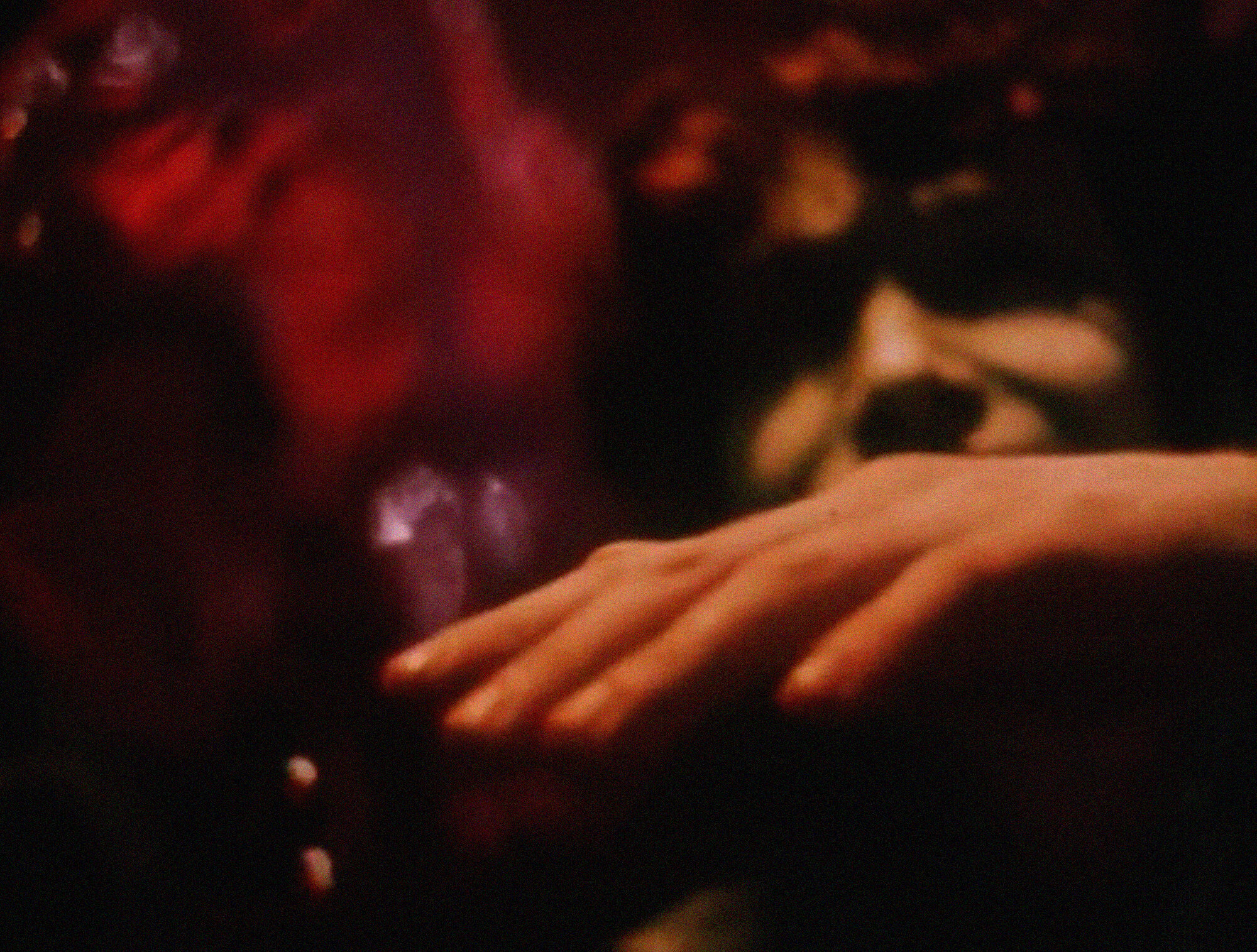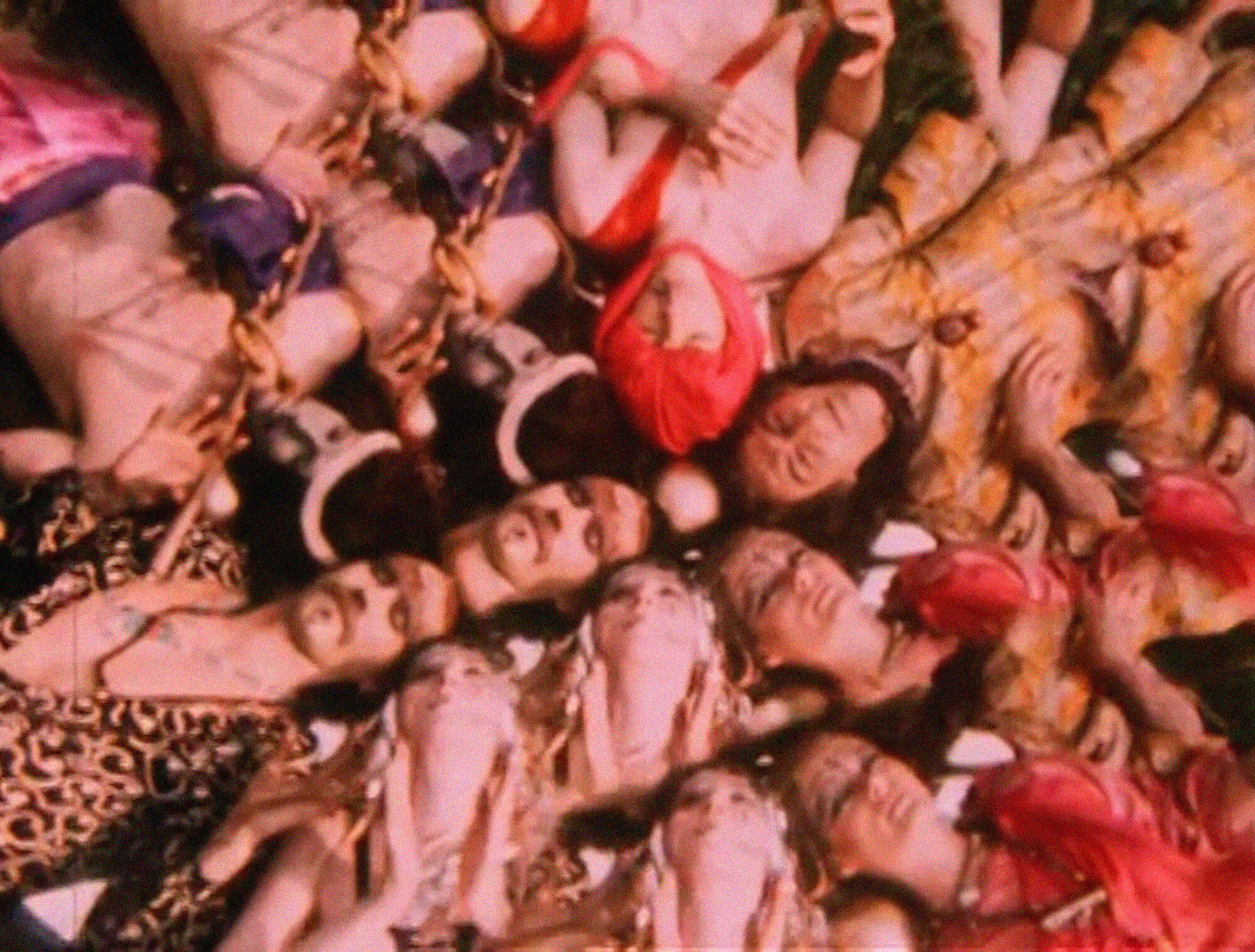Heavenly Pavilions: Ira Cohen’s The Invasion of Thunderbolt Pagoda
Art & Trash, episode 3
Heavenly Pavilions: Ira Cohen’s The Invasion of Thunderbolt Pagoda
Stephen Broomer, February 18, 2021
Ira Cohen’s The Invasion of Thunderbolt Pagoda, a major work of communal performance and psychedelic abstraction, emerged from the New York scene in 1966 to great acclaim. The seed of the film was Cohen’s photography, in which he used mylar sheets to create eerie, otherworldly abstract portraits of friends, often wearing bizarre and grotesque makeup that transformed them into gods and devils, forming an ensemble he called the Universal Mutants Repertory Company. In Heavenly Pavilions, Stephen Broomer discusses Cohen’s work in relation to the artist’s ideas about media, the relation of his aesthetics to those of other underground filmmakers, and the film’s esoteric spirituality.
The Invasion of Thunderbolt Pagoda was released on DVD by Arthur Magazine, in two print runs, both of which are now sold out. That version, which includes Cohen’s 2006 prologue, is the one that was used to make this video essay. The 2006 restoration of the film was effected through the efforts of composer Will Swofford.
The Invasion of Thunderbolt Pagoda is available for rent on 16mm from the New York Filmmakers Cooperative. For further information, please consult film-makerscoop.com/catalogue/ira-cohen-invasion-of-thunderbolt-pagoda-the
For a fuller context on Cohen’s life and work, purchase Allan Graubard’s exceptional collection Into the Mylar Chamber - fulgur.co.uk/books/into-the-mylar-chamber/ - which gathers high quality reproductions of Cohen’s photography with essays and commentary by Graubard, Ian MacFadyen, Thurston Moore, Alice Farley, and Timothy Baum.
SCRIPT:
Ira Cohen was born in 1935 to deaf parents, and was subsequently raised in the Bronx's deaf community. He would later credit this experience for instilling in him a particular discipline for visual communication. Cohen came of age in New York's downtown scene at the height of its psychedelic and eastern mystical curiosity. He spent much of the early 1960s undertaking the sorts of journeys that had become rites of passage among the beat poets. He lived in Tangiers for a time with William S. Burroughs and Paul Bowles, following the same exotic trajectory as figures like Jack Kerouac, Allen Ginsberg and Irving Rosenthal.
Cohen was a prolific but largely unheralded poet and by the mid-1960s had established himself as an important publisher of underground magazines. He would remain focused on poetry until his death in 2011. But his greatest success, and his most influential contribution to psychedelic art, was his mylar chamber, a room in his New York apartment that had been decorated entirely with rolls of mylar. These strange reflections allowed for extraordinary distortions of a subject, bending light as in a funhouse mirror, pliable enough that the bend of that light could be manipulated. With mylar, Cohen could stretch faces, elongate fingers, and curve bodies in the smooth, bulbous, unbroken lines of post-Picasso figuration. In his photography he often used this effect on subjects outfitted in the style of the era, or bearing bizarre and often grotesque facepaint and prosthetic makeup.
Cohen found himself immersed in a world of renaissance sensibilities, and surrounded by artists who often worked between music, cinema, and the visual arts. In the spirit of communal art making, and as an experiment in intermedia, Cohen would make a 16mm underground film that would serve as a declaration of his spirituality, and as a vessel for the plastic illusions of his photography. The Invasion of Thunderbolt Pagoda set Cohen's mylar chamber in motion, along with the cast of strange and often terrifying figures that had occupied it. These characters were fully-realized in Cohen’s poetics: the Majoon Traveler, the Methedrine Cardinal,
For The Invasion of Thunderbolt Pagoda, Ira Cohen developed a large ensemble, the Universal Mutant Repertory Company, a collective of thirty-four performers, gathered from New York's downtown scene, among them, underground filmmakers Sheldon and Diane Rochlin, and musicians Tony Conrad and Angus MacLise, who were then members of the Theatre of Eternal Music. These and other downtown scene artists are complemented by a number of one-named models and mystics.
The film emerges out of three strains in Cohen's work. First, his interest in the relation between expanded consciousness and the forms of knowledge and communication that were being revealed by a new age of media art and philosophy. His ensemble is an electric tribe, if not that of Marshall McLuhan, then certainly that of Andy Warhol's The Exploding Plastic Inevitable. Second, Cohen's interest in the possibilities for spiritual and physical transformation through art, as realized through the bending lightflow of mylar reflections. And finally, his preoccupation with occult fantasy in which figures are transformed into a psychedelic bestiary by prosthetic makeup, face paint, and trick photography. The Universal Mutants could at once be an androgynous congregation performing a black mass, or a commune of free souls engaging in collective dreaming in a lost paradise. The soundtrack, by Angus MacLise, supports Cohen's ideas through sensory overload, mixing tape manipulation and feedback with heavily overdubbed flutes, bow'd strings, and drones.
Cohen planned the film in three parts: the Opium Dream, Shaman, and Heavenly Blue Mylar Pavilions. The first of these sequences, the Opium Dream, offers up the imagery that the Living Theatre's Julian Beck would later use to describe Cohen's film, when he called it a combination of Kabuki theatre and Doctor Strange, implying that Cohen was at once arcane and foreign, deeply western and pop. In the Opium Dream, figures enact strange rituals while smoking from pipes, figure and pipe distorted by mylar, transformed by fantastical costuming and makeup into gods and devils. Between title, action, and atmosphere, the Opium Dream establishes that the film is a trip. Through its anesthetic haze, it gives a tour of underground styles and introduces the film’s own cosmic iconography, prominently featuring a robed sorcerer, and men costumed as snakes and bats. Cohen’s preoccupation with pan-Asian aesthetics are present in the kimonos, pipes, facepaint, hand fans, and the textile patterns of outfits and curtains. The Opium Dream depicts a candlelit ritual, a feeding of beasts. Symmetrical mirroring and mylar distortions keep company with more direct imagery of these exchanges. Cohen presents a wholly realized imaginary space where the Universal Mutants, their symbolic totems and baubles, and the technology which transforms them become a unified whole. This is at its clearest leading into the climax of the sequence, as kaleidoscopes and mylar reflections collapse all of these elements, just before the appearance of a dancing reaper, and the start of a frantic ritual orgy of violence and music.
The Invasion of Thunderbolt Pagoda bears debts to underground films not merely of its era but from its immediate community, such as Jack Smith's Flaming Creatures, a film with which it shares multiple contributors, as well as the films that Ken Jacobs made as extensions of his and Smith's street theatre performances, which often featured carnivalesque clothes and makeup. The overt presence of occult imagery, suggestive at times of Egyptian and Tibetan mysticism, links The Invasion of Thunderbolt Pagoda to the Magic Lantern Cycle of Kenneth Anger, in particular, Inauguration of the Pleasure Dome, Anger’s hallucinatory, technicolor reflection of his fascinations with Aleister Crowley and the esoteric faith of Thelema. Like Anger, Cohen is not only making art. but gathering an unconventional family. under the sign of an idiosyncratic faith. And again, like Anger, Cohen is staging a performance, a history of the mysteries, a history of appearances. He summons his Repertory Company to the bent mirror of the ancients. Through it, they become primal vessels of poetry, technicians of the sacred.
The second sequence of the film, Shaman, uses kaleidoscopes extensively. It takes this ritual out of the mylar chamber and into the verdant green pastures of a sunny day. Men and women play musical instruments and dance, enacting a strange ritual in nature. This hippie pastoral is due to be complicated by Cohen’s trick photography. While the mylar reflections had enhanced the mystery of the set in the Opium Dream, in Shaman, the light of the sky makes the background of distorting leaves and branches both finite and impossibly deep. The mylar splits faces so that a single figure appears to move in two different directions. The ensemble lays on the grass, their heads together, passing around the sorceror’s golden orb. A kaleidoscope splinters and repeats their faces, multiplying six bodies into a growing field of flesh. The flesh expands further in the mind's eye. The cheek of one and the bare chest of another, and the folds of their clothes and the glint of their chains become inextricable. They become a single mass, a many-headed creature with a dozen darting eyes.
The illusionism of Cohen’s mylar and kaleidoscopic photography reminds of Sidney Peterson’s extensive use of anamorphot lens distortion in his films of the 1940s. Anamorphic distortion of the image allows the subject to be stretched vertically and horizontally as the lens was adjusted. For Sidney Peterson, this became the most accurate mirror for the bent souls and fractured identities of his subjects and of postwar experience in general. In the first two sequences, Ira Cohen’s trick photography serves a similar purpose. It abstracts the image and develops an atmosphere that supports its mystic traits. Backgrounds become murky and distant and familiar sights are rendered in unnatural dimensions, realizing the strange citizens of the mylar chamber.
The final sequence, Heavenly Blue Mylar Pavilions, is the most non-objective. It is a rendering of blue sky in fluctuating mylar, a subject that allows the pure distortions of the mylar itself to come to the forefront, an entrance into the Tibetan Upper World. The material fact of Cohen’s process is at its clearest, but the reflections are no less mysterious. The mylar reflects fleeting bits of image – in the foreground, Cohen’s hands wave a wand, repositioning the folds in the mylar’s surface. The final image is of a waterdroplet dancing on this wavering sky.
When The Invasion of Thunderbolt Pagoda was restored in 2006, Cohen made a new introduction using the film’s voluminous outtakes. In this prologue, Ira Cohen is buried in mud, nude, his Universal Mutants hoisting shovelfuls of mud on him while performing a Dionysian ceremony, beating drums and blowing horns. Only once he is fully cocooned within the mud does he break its surface, sitting up out of it in a trance, reincarnated as one of those dying and reviving gods of James George Frazier’s The Golden Bough. His mad stare is fixed on the camera as he pulls himself to his feet to lead the burial party in a procession, dancing, the conductor of his own mysteries.
FURTHER READING:
Allan Graubard (ed.), Into the Mylar Chamber. Lopen, Sommerset, UK: Fulgur Press, 2019.
Douglas Martin, “Ira Cohen, an artist and a touchstone, dies at 76.” The New York Times, May 1, 2011.





